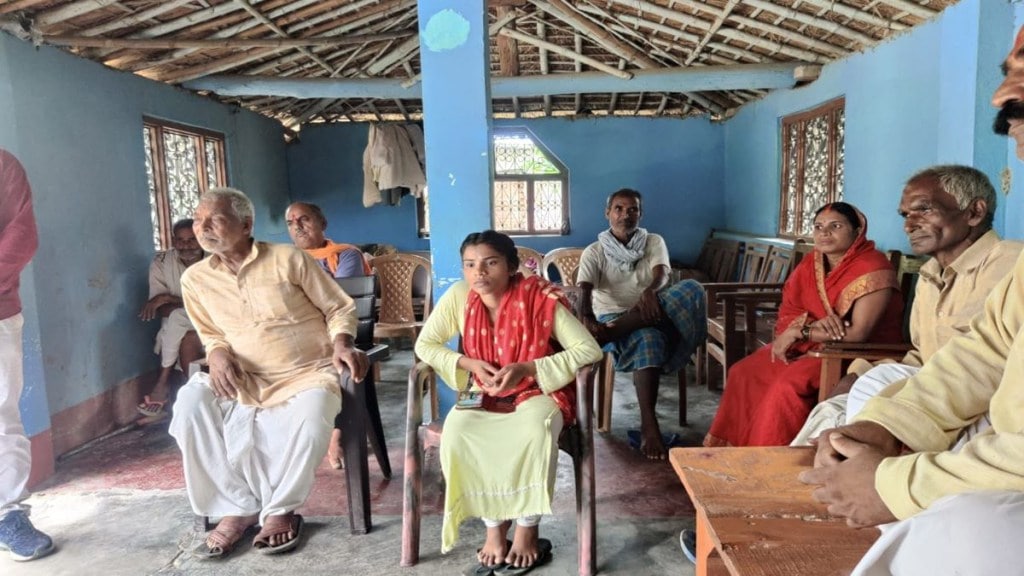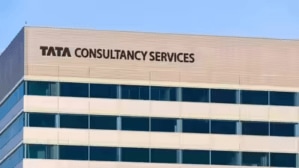Sunita Paswan, 27, noticed the swelling in her legs for the first time when she was in Class 9. While she initially didn’t pay much heed to it, as her legs got more swollen and after trying everything to cure it, she got to know that she is suffering from Lymphatic Filariasis, a neglected tropical disease in which the infection occurs when filarial parasites are transmitted to humans through mosquitoes.
Lymphatic filariasis, commonly known as elephantiasis or ‘Hathi Pao’ not only causes physical disablity, but the patients also suffer from mental, social, and financial losses contributing to stigma and poverty.
India is a major contributor to the global burden, accounting for over 40 percent of all LF cases globally. Moreover, approximately 640 million people in India are currently at risk of contracting the disease. Meanwhile, 90 percent of the LF burden in India rests upon eight tropical states including Uttar Pradesh, Bihar, Jharkhand, West Bengal, Chhattisgarh, Maharashtra, Odisha, and Madhya Pradesh.
Financial Express.com visited three villages of Uttar Pradesh’s Deoria district–Sikataya, Jagdishpur, and Mishrauli–to understand the current status of the disease and its impact on the people.
Sunita Paswan hails from Jagdishpur village of Uttar Pradesh’s Deoria District, one of the high-burden districts of LF. The vector-borne disease is a leading cause of permanent disability worldwide. The infection is caused by parasites classified as nematodes (roundworms) of the family Filariodidea.
“I came here from Husband’s home…I am living with my parents for the last 1 year. I got involved with this campaign…I was depressed so I used to talk less. Then, I decided when my life is already destroyed…I want to make sure nobody else’s life gets ruined. I exercise every night and morning…and in the afternoon too whenever I get time. I have no pain now in my legs. I was in Class 9 and I had went to aunt’s place…when I first noticed the swelling…we tried a lot…but it couldn’t be cured. I tried some remedies and for 3 years everything was normal. After I got married…the swelling was back. I used to cry…but who is going to care for you in your in-law’s house? So, my mother asked me to come back home and go back after getting better. But my husband’s and in-laws stopped calling now,” Paswan who is now a part of patient support group for LF told Financial Express.com.
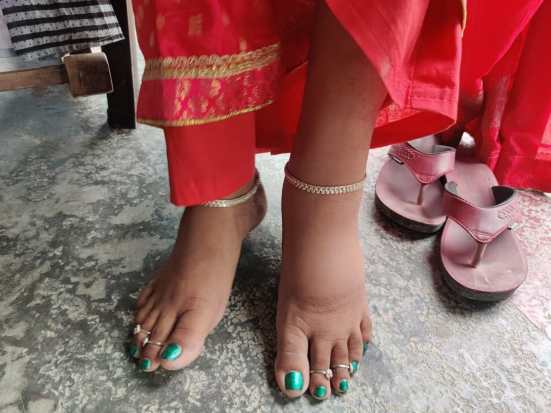
According to WHO, Wuchereria bancrofti, one of the three types of filarial worms, is responsible for 90 percent of the cases. The symptoms of the painful and profoundly disfiguring visible manifestations of the disease – lymphoedema, elephantiasis and scrotal swelling or hydrocele – start showing after almost 10-15 years.
India’s Commitment to eliminate Lymphatic Filariasis by 2027
In January this year, Union Health Minister Mansukh Mandaviya while inaugurating the National Symposium on India’s Roadmap to Eliminate Lymphatic Filariasis, reiterated India’s commitment towards the target of eradicating the disease by end of 2027.
In order to eliminate the disease, the health ministry has come up with a renewed five-pronged strategy as part of which mass drug administration (MDA) will be held twice a year on February 10 and August 10.
On February 10 this year, the first phase of the MDA round were conducted in in 10 states. On August 10, the MDA exercise was launched in nine endemic states to reach its target of lymphatic filariasis elimination in the next four years. The campaign covered 81 districts in nine endemic states— Assam, Bihar, Chhattisgarh, Jharkhand, Karnataka, Maharashtra, Odisha, Telangana and Uttar Pradesh.
Role of Patient Support Groups and ASHA workers
Dr. Rajesh Jha, Chief Medical Officer, Deoria District explained that the problematic aspects of diseases like Filiariasis is that these are chronic infections.
“As the effect the of these diseases aren’t seen immediately, controlling these diseases and making people understand is very difficult. In covid, people immediately realised that it is dangerous and they took measures to control the spread. Right now, the chronic cases that you are seeing in case of Filiariasis are happening in the older-age group. So, awareness is extremely important, Dr. Jha told Financial Express.com.
In the Deoria district, the MDA rounds were conducted from August 10 to August 28 and ASHA workers went door-to-door to give the dual therapy–Diethylcarbamazine citrate (DEC) and albendazole to people while explaining how these medicines can prevent the disease. During these rounds, ASHA workers often face several challenges like patients refusing to take the medicines.
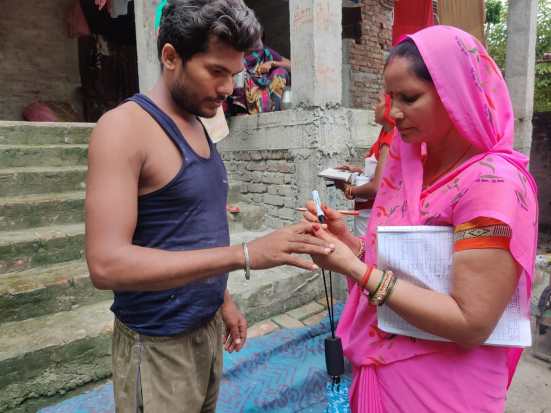
In the Sikatiya village of Bankata block, Premsila Devi, a ASHA worker, handles 183 houses. With a bag of medicines and a register, Devi visits house after house giving medicine to the family members, marking the houses and re-visiting if a family member is left. She along with 2 other workers are responsible for this village.
“…a lot has changed now. As more and more people are aware of this disease…very few people say no now. Earlier, there were a lot of issues,” she told Financial Express.com.
Akhilesh Kumar Singh, Sarpanch of the Sikatiya village told Financial Express.com that they are conducting a lot of welfare programmes to increase awareness about this disease.
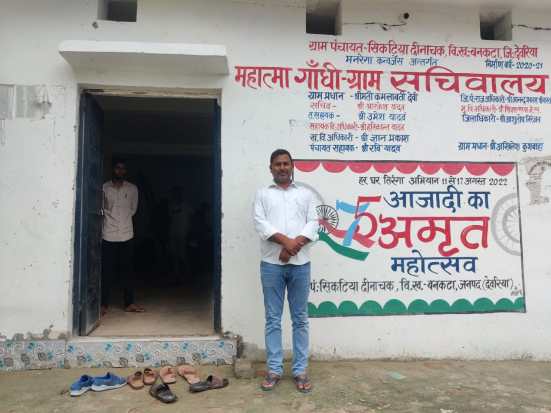
“We are working along with Samuh Sakhis to raise awareness about Lymphatic Filiariasis like wall writing, rallies, etc. We are raising awareness on how this disease can be prevented, what happens after the infection, and now because of increased awareness people are now willingly taking drugs during the ongoing Mass Drugs Administration (MDA) rounds. Till now, there has not been any incident of denial. Earlier, people used to think that Filiaria is a disease and they should consume medicines only after contracting the disease. But now we know, that this disease cannot be treated. It can only be prevented,” Singh revealed.
He also informed that there are 11 people in our village who are elephantiasis. We are now taking these people as examples to raise awareness about this disease, he said.
Samuh Sakhi, committee of women, often accompany ASHA workers to aware people about the disease and the impact of these medicines. Meera Devi, one of the Samuh Sakhis told Financial Express.com that people are now willingly taking medicines.
“We have been explained about Filaria. Earlier, people didn’t know much about the disease. We now know that this disease is caused by Culex mosquito. We are encouraging people to consume the Anti-Filaria medicines. Earlier, people were hesitant to take these medicines but now they take it willingly. People are now scared of this disease,” she said.
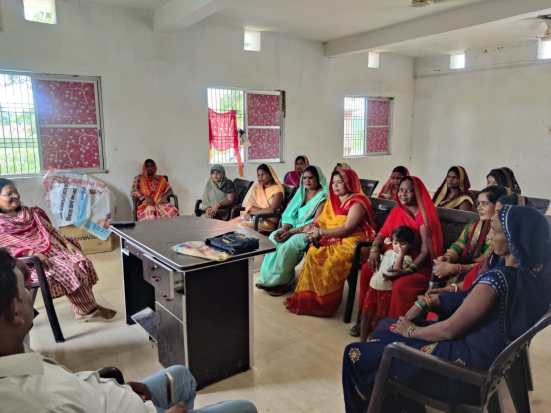
Meanwhile, Patient Support Groups have become a core part of raising awareness about MDA, removing the stigma around the disease, and promoting healthy habits among patients. In Uttar Pradesh, such groups are operating in Kanpur, Lucknow, Deoria, and Ballia. One of the main objectives of these groups is to enable the patients-survivors to connect with each other and promote patient-survivor involvement in strengthening the elimination programme.
There is both denial and fear of disclosure among those affected by the disease. Consequently, there is a delay in seeking timely medical advice which leads to unchecked progression of the disease. With the emergence of these support groups and networks across the region, there is a wind of change. The members also get training in Morbidity management and disability prevention (MMDP).
According to WHO, to achieve the aims of the second component as outlined in the 2011 morbidity management and disability prevention (MMDP) position statement, a minimum package of care for every person with lymphedema, elephantiasis, or hydrocele must be available in all areas of known patients where LF is endemic.
Moreover, some of these members are connected with district and block health systems, partners, and all local stakeholders to successfully complete the MDA campaigns in February and August. In the Deoria district, 850 patients have been mapped out of which 240 are men and 610 are women.
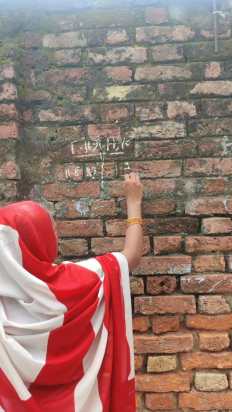
In the district, the Filaria PSGs-Networks are assisting in finding and linking patients from their own village and the surrounding areas to the patient network. They are helping newly identified patients to access healthcare services by linking them with health facilities. They are also coordinating with the Health Department to provide training in self-care or MMDP and secure MMDP kit, which comprises of bucket, soap, and anti-fungal cream.
Every month, these members conduct meetings to identify issues faced by members of the PSGs–Network and write to the respective officials/departments about their concerns. During these gatherings, they also discuss about the importance of personal hygiene and regular exercise.
During one such meeting in the Jagdishpur village, the members told Financial Express.com that proper compliance with personal hygiene, and keeping their feet in an elevated position helped them to reduce the lymphedema or swelling and prevent acute attacks of high fever and unbearable pain.
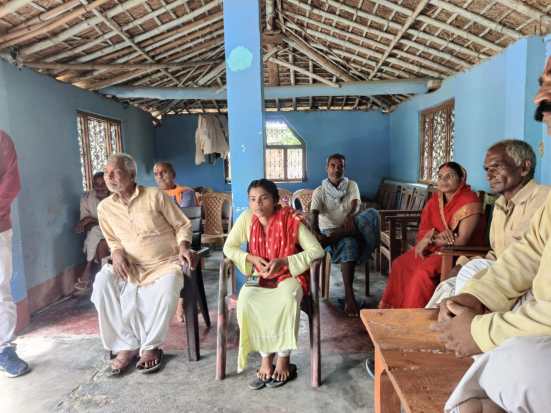
Interestingly, they also gather information from the drug administrator (ASHA) about individuals who were absent during the previous drug administration round and convince them about the importance of taking the medicine.
Paswan who has been a member for months now told Financial Express.com that joining this group has changed her life.
“…Now I talk to other people in the village and explain to them how this disease affected my life. Despite being educated, I used to act like unaware people. When ASHA didi used to come to our home, I used to think why should take these medicines…I will never get this disease. I used to throw away the medicines. I don’t want others to do the same. People listen and then they take the medicines…Its my own village so we sometimes continue with the drug administration till 8 pm too. My brothers were not supporting my work as a member of this group. Now, the whole village is supporting me,” she said.
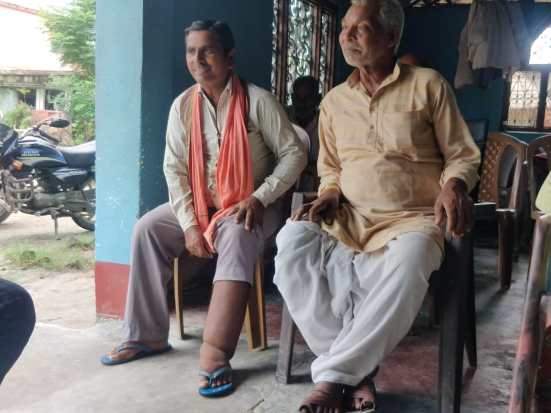
Other than helping ASHA workers, these members also go to schools and educate the students about vector-borne diseases. There are support groups in every village that raise awareness about diseases like Filiariasis and Kala Azhar.
‘I show my leg as an example to make people aware of this disease’
Bir Bahadur Gupta, 50, lives in the Jagdishpur village. He is a part of the Patient Support Group and he is not only reaching out to the people of his own village, he also visits people from surrounding villages.
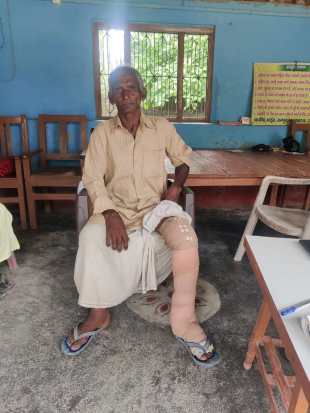
“The swelling started around 14-15 years ago. I was around 50 years old back then. Earlier, the swelling was way too much. My legs used to be so heavy and it was extremely difficult to move or walk. My slippers last for hardly a month. I don’t want others to suffer like me. I go to other villages, talk to people, show them my leg and tell them that if they don’t take the medicines, they will become like me. I tell them if they don’t give medicines to their sons or daughters they will become like me…I tell them…if your daughter becomes like me…then she will face difficulty in marriage,” Gupta told Financial Express.com.
He also shared that people are now more aware about this disease. Other members of the group shared that he would contact people prior to the MDA rounds to motivate them to take the medicine.
He has now made it a point to connect with those who had missed doing so in the last round. He would share his experience with the disease and urge them to not miss it this time. It is noteworthy that a list of those who had refused medicines was provided to him by the Health Supervisor, Bankata and ASHA and very diligently he goes to houses of the people who refuse and personally to motivate them.
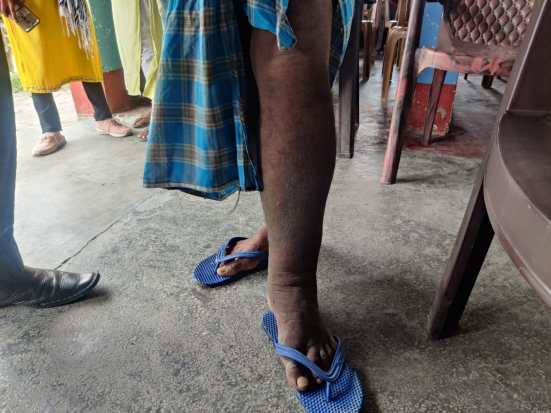
Moreover, Gupta also took the initiative to share information on self-care and give training after distribution of MMDP Kits to patients.
“…since there is no treatment, we focus on management to avoid further complications and deterioration. In these aspects, CFAR and the patient support groups have been at the forefront. Since, these people are very few…and there are no new cases…things are getting easier to manage as people are getting more and more aware. We are on the right track…of course, covid did slowed us down a bit…but we are all set. There are now no new elephantiasis cases…this is a very big achievement,” Dr. Jha told Financial Express.com.
‘We cannot slow down’
Dr. Jha highlighted that earlier, they used to tackle this disease symptomatically now there is a focus on early diagnosis.
“There was no focus on the preventive aspects and there was a lack of protocols before…Now the challenge, when there is no immediate effect it hard to convince people to participate in Mass Drug Administration…In Community Health, it is extremely important that achieve 80-85 percent coverage to get the desired effect,” he pointed out.
Now that we have started doing MDA and started doing treatments, fresh elephantiasis cases aren’t coming up, he claimed.
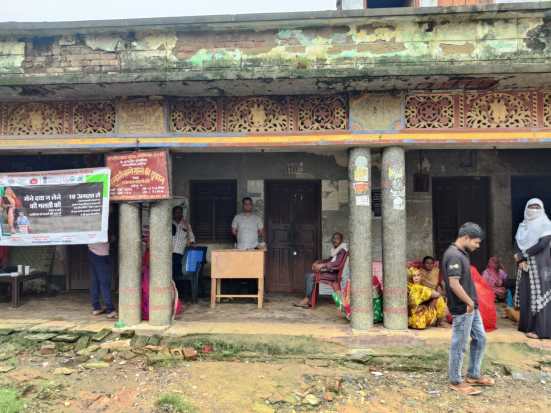
“…people even in case minor swelling quickly goes to the doctor and the permanent damage is being stopped. However, if we don’t properly focus on the elimination or eradication phases, the moment we slip, the already achieved status will go to waste. We have to keep the momentum going till the time the disease gets completely eradicated. Since symptoms of the Filiariasis start showing after 10-15 years we have to keep doing the mass campaigns regularly,” he added.
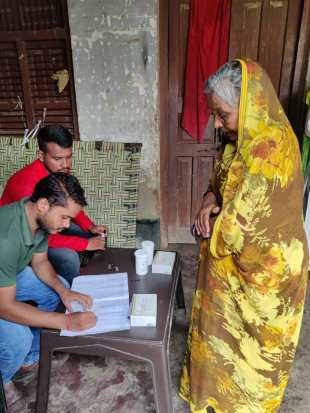
Dr. Bhupendra Tripathi, Country Lead, NTD Elimination, Bill & Melinda Gates Foundation (BMGF) told Financial Express.com that for the successful elimination of Lymphatic Filariasis, there is a need to implement a comprehensive vector control program, led by experts in entomology, to target and minimise the disease-carrying vectors.
“Moreover, the bolstering of funding is critical to ensuring that we are able to extend our reach across the remotest areas. These concerted actions are the keys to overcoming these challenges and achieving our goal of eliminating this disease,” Dr. Tripathi said.

